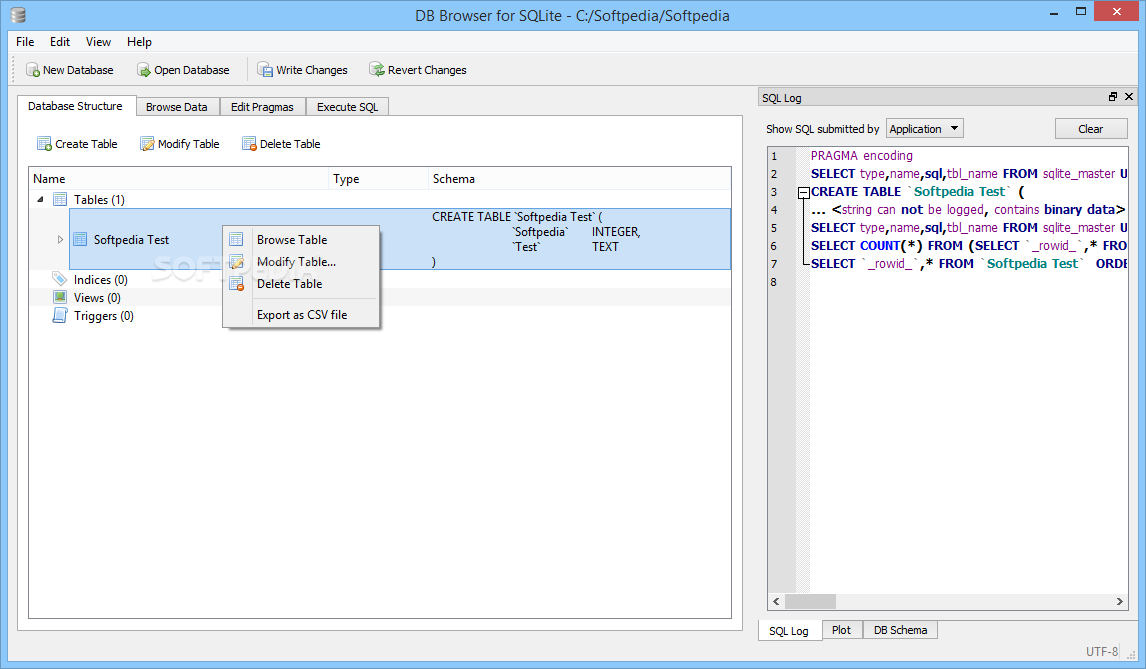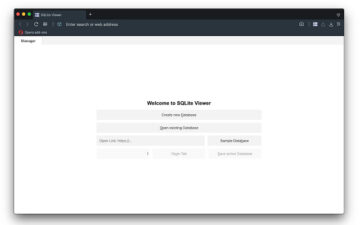


Primarily a middle-state format, typically in active use for recording transactions.įile formats used by SQLite version 1.0.x (initial release in August 2000) and version 2.x (initial release in September 2001), not described separately on this website at this time.
#Db browser for sqlite extension code#
Header fields include a magic number page size in bytes fields relating to the number of pages of various types a code indicating the encoding used for text data (UTF-8, UTF-16le, or UTF-16be ) minor version number for the SQLite engine used to write the database file a code to indicate whether the database is running with write ahead logging ( WAL) and codes that indicate whether the database is configured for vacuuming. The first 100 bytes of the database file act as a header. Row data is stored as records, each with a header that indicates the data type for each value in the row, followed by a sequence of values, usually one value for each column in the table. Each entry in the table b-tree corresponds to a row of the SQL table. These are extra pages inserted into the database to make the operation of vacuuming more efficient.Įach ordinary SQL table in the database is represented by a table b-tree. A database may be configured for vacuuming to reduce or eliminate the freelist. Unused pages are stored on the freelist and reused when required. The freelist is a linked list of freelist trunk pages, each of which contains page numbers for zero or more freelist leaf pages.

A database file may contain pages that are not in active use, for example, after information is deleted from the database. It is not needed for modern operating systems, but is retained for backwards compatibility. The lock-byte page was needed to support Win95. When the payload of a b-tree cell is too large for the b-tree page, the surplus is spilled onto overflow pages. A 100-byte database file header is found on page 1. A second b-tree variant storing only keys is used in SQLite_3 and called an index b-tree. SQLite calls this variety of b-tree a table b-tree. The algorithm that Donald Knuth calls B*-Tree in "The Art of Computer Programming" (Volume 3, Sorting and Searching) stores all data in the leaves of the tree. The b-tree pages hold the main database content. The smallest SQLite_3 database is a single 512-byte page.Įvery page in an SQLite_3 database file is of a particular type: The theoretical maximum size for an SQLite_3 database file is about 140 terabytes typically, the file size limit of the underlying filesystem or hardware is the practical constraint. The page size for a database file is indicated by the 2-byte integer located at an offset of 16 bytes from the beginning of the database file. The size of a page in bytes is a power of two between 56 inclusive.

All pages within the same database are the same size. The main SQLite_3 database file consists of one or more pages. See Appropriate Uses For SQLite for more detail on when SQLite is appropriate and examples of when a client/server SQL database engine would be more appropriate. They are designed to implement a shared repository of enterprise data SQLite is designed to provide local data storage for individual applications. SQLite is not directly comparable to client/server SQL database engines such as MySQL, Oracle, PostgreSQL, or SQL Server.
#Db browser for sqlite extension software#
See Adoption under Sustainability Factors below for examples of the many operating systems and software applications in which it is distributed or used. These features make SQLite_3 a popular choice as an application file format. The database file format, referred to here as "SQLite_3", is cross-platform, transferable between 32-bit and 64-bit systems or between big-endian and little-endian architectures. The engine, and thus the file format, support a full-featured SQL implementation. A complete SQL database with tables, indexes, triggers, and views, is contained in a single disk file. SQLite is an embedded SQL database engine that requires no configuration and reads and writes directly to ordinary disk files. The code, software, and accompanying documentation have been dedicated to the public domain. Software and associated documentation are available at. SQLite, version 3, is the file format used as the publicly documented native format for the SQLite database engine since June 2004.


 0 kommentar(er)
0 kommentar(er)
